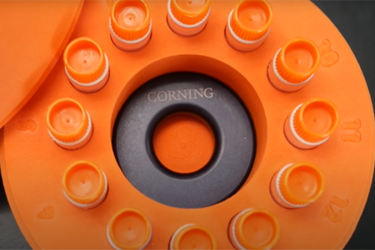Corning® CoolCell®
Look to Corning® CoolCell® alcohol-free freezing containers, cryogenic vials, and accessories for reproducible, controlled-rate freezing for stem cells, primary cells, cell lines, and more.
Isopropanol (IPA) containers used for cryogenic freezing require costly alcohol replacements every 5 uses, can be cumbersome to handle, and may have inconsistent freezing rates. Corning CoolCell is different, because it’s a reusable, alcohol-free way to uniformly freeze your cells at a reasonable one-time cost. With CoolCell, you can depend on high reproducibility and high cell viability, to ensure you preserve the most cells possible for your research.
Unique features of controlled-rate freezing with CoolCell include:
-
Ease of use
-
Alcohol and fluid free freezing
-
Lower cost of use than alcohol-based devices
-
High post-thaw recovery and viability
-
Proven reproducibility for a variety of cell types
-
Simple, consistent way to standardize controlled-rate freezing
For permanent sample identification and a reliable chain of custody, use Corning 1D/2D bar coded cryogenic vials featuring synchronized permanent, laser-etched 2D Bar Codes on the bottom of the vial as well as linear Bar Codes on the side of the vial. The vials are made of temperature-resistant polypropylene that can withstand temperatures down to -196°C and are compatible with most scanning and capper/decapper systems.
Cryogenic Storage Products
Corning CoolCell: Controlled-rate, Alcohol-free Cell Freezing
Corning CoolCell alcohol-free cell freezing containers ensure standardized controlled-rate, -1°C/minute cell freezing in a -80°C freezer—without alcohol or any fluids.
CoolCell cryogenic containers are proven for use with a variety of cell types including stem cells, primary cells, PBMC, cell lines, insect cells, yeast, and others. The patent-pending CoolCell technology utilizes a thermo-conductive alloy core and highly-insulative outer material to control the rate of heat removal and provide reproducible cell cryopreservation. CoolCell units are easy to use and deliver comparable results to expensive programmable freezers at a fraction of the cost.
Performance Test: A temperature probe was placed into a 2.0 mL cryogenic vial containing 1.0 mL of water and the tube was inserted into a room temperature CoolCell. The CoolCell was placed into a -80°C freezer and the temperature rate and profile was recorded over a 3 hour period. The test was repeated 5 consecutive times.
Conclusion: CoolCell generated identical fusion time and cooling profiles over five consecutive freeze cycles.

